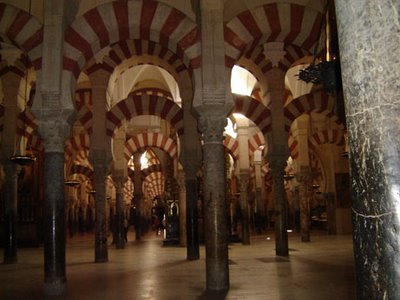Here are additional photographs of La Mezquita of Cordoba:



Later that day, my travel companions and I took a walk through the gardens of El Alcazar de los Reyes Cristianos. The gardens had beautiful pools, flower beds and shrubs grown in interesting patterns.

Most impressive perhaps were the gigantic and dense cedar columns surrounding the gardens. Here they are pictured with statues of King Ferdinand and Queen Isabella receiving Christopher Columbus on the eve of his departure for the New World.

What made our stay extra special was our late night walk through Cordoba's narrow, winding streets and happening upon a moderate-sized square, filled with people -- a free flamenco concert was taking place! As we grabbed seats, a male singer accompanied by a very skilled young guitar player belted out his pangs and passions, undoubtedly about his lost love. Next came a singing/dance quintet -- they clapped and stomped their feet to the sizzling music.

I was charmed by the intimacy of the event. In the back, I caught a glimpse of the fellow who was our waiter at Hostal Deanes, also enjoying the concert.
The next morning, before we left, we ate at another beautiful courtyard restaurant/guesthouse. We had a delicious breakfast of cafe con leche and toast with a meat spread that tasted very much like pureed soppressata, one of my favorite foods. One of my travel companions had a luscious apple tart that we all helped her devour.
I will never forget Cordoba, especially for the delicious gazpacho I ate there and the Andalusian cookbook that I bought! Until next time . . . I'll let your mouth water.
First -- Andalusia -- which I think will always hold a special place in my heart. We visited first Cordoba and then Granada. We meant to go to Seville too, but unfortunately didn't make it.
The Andalusian countryside. The area we drove through was surrounded by hills that were parched yellow, almost like a desert, but planted efficiently with rows and rows of olive trees. We also passed lots of vineyards and safflower fields. The interesting thing about these farms was that they were pretty much devoid of structures or traces of life working them, giving an eery, desolate feel. Perhaps its just too hot to be out there.
Cordoba. We stayed in the coolest place, the Hostal Deanes, which is just steps away from La Mezquita, the Great Mosque, perhaps Cordoba's most frequented monument (see a satellite view of it here). The Hostal Deanes was fabulous for the warmth of its service, its beautiful courtyard and its delicious (although slightly salty for American taste) food. The structures in Cordoba are fantastic. At the center of the hotel is a beautiful courtyard, with a fountain in the middle.

For the ceiling, we had the bright blue sky (see below), with a retractable tarp for rainy days (if there are any).

In the courtyard, they had a tapas restaurant, where I ate my first Andalusian gazpacho, perhaps my favorite food of all time. I love it so much that it deserves its own entry at a later date. Surrounding the courtyard are their very affordable and charming rooms -- all of five.
La Mezquita, the Great Mosque, began life as a Visigothic church in 780 A.D. It was then transformed into the religious center of the Moorish kingdom of El-Andalus in 987 A.D., and then was converted to a Christian church in 1253, after Cordoba fell to the Christians in 1236. There I saw for the first time the intricately designed geometric tiles of Moorish craftsmen, with some impressive, somewhat gaudy Christian craftsmanship as well.
I need to continue my tales of La Mezquita on another day, with lots of pics that I don't have the patience to upload now. Until next time . . .

